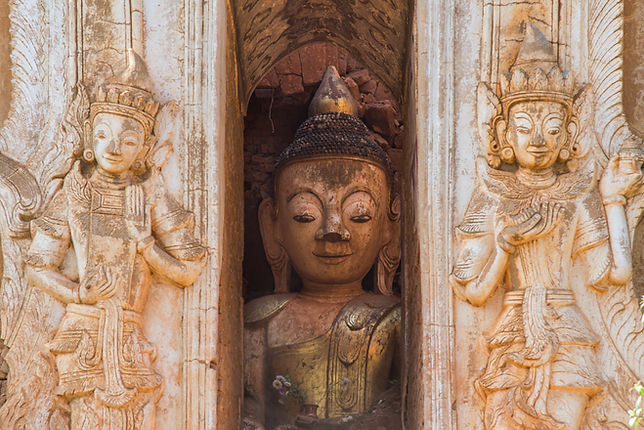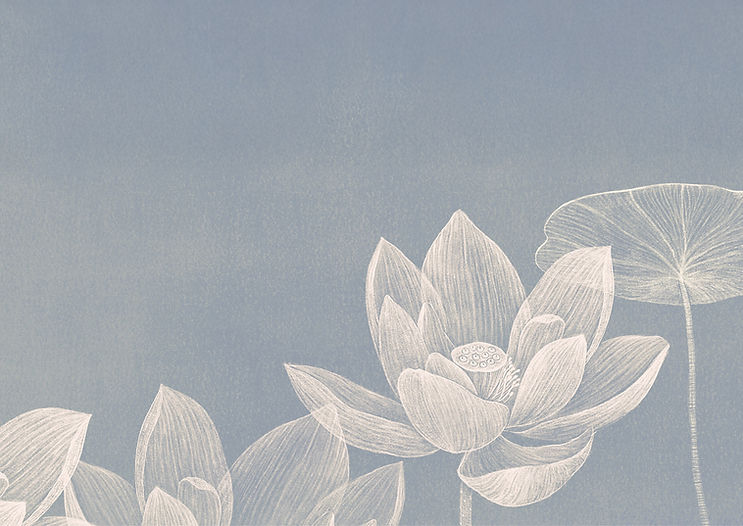
BUDDHISM IN ASIA:
ANTHROPOLOGY & EVERYDAY LIFE
Workshop (Hybrid Event)
5 June 2025, Departemt of Anthropology, UCL
The study of Buddhism in everyday life is inherently interdisciplinary. Abstract Ideas such as enlightenment, renunciation and karma are often interwoven into the complexities of daily realities. This workshop explores Buddhist-influenced material culture, embodied practices, and everyday experiences across Asia through conversations with scholars, spiritual teachers, and Buddhist practioners.
The workshop features two thematic sections: Wellbeing, Environment, and Sociality and Tourism, Education, and Visual Culture.
Each section will feature a keynote speech, presentation and a discusion session. Between the two themetic sections, there will be a Spiritual Interlude for spiritual teachers from Tibet, Thailand, and Japan to share their insights on contemporary concerns raised.
Wellbeing, Environment, and Sociality
Keynote Lecture
Professor Jo Cook, UCL
'Making of oneself an island’: Buddhist Meditation and the Anthropology of Freedom
In this paper I sketch out what an anthropology of freedom might contribute to our understanding of Buddhist meditation. I compare the ethical projects of meditators in two very different contexts where I have worked: Buddhist monasticism in Thailand and therapeutic culture in the UK. In both, freedom takes on an important normative value as a telos but to drastically different ends. Focusing on meditation on the body, I reveal the contrastive ways in which ideas about freedom inform meditators’ experience and understanding of their bodies. I argue that, in both cases, freedom is shaped by cultures of practice, and the ways in which people relate to it, inhabit it and indeed embody it are necessarily complex and ethical.
Panel I
Paula Bronson, UCL (Online)
Without my hungsa I will die”: The Bombos, Nepal’s Tamang Indigenous Buddhist Healers.
This talk will present the Tamang Bombos and situate their role as Buddhist healers and mediators of the relationships between the spirit world and the lives of the villagers with whom I worked during my doctoral research in rural Nepal. Through ethnographic descriptions of a healing ritual for a man who had his life force or hungsa in Tamang taken by a ghost, this talk will detail this shamanic practice and its place within everyday Buddhist traditions.
Bo Yang, UCL
Revealing Karmic Plant: The Borderline between Tibetan Pastoralists and Buddhist Sacred Ecology
This presentation interrogates the moral modelling inherent in Tibetan perceptions of plants, grounding its analysis in the sacred ecology that emerge at the intersection of human groups, non-human species, folk spirits, and dharmic beings. Focusing on ethnographic contexts of the karmic plant – caterpillar fungus (Cordyceps sinensis, Tib. Yartsa Gunbu) – harvested by Kham Tibetan pastoralists in the eastern Tibetan Plateau, China, this study examines the epistemic complexities in relations to multi-modalities of animation surrounding this organism. Drawing upon Tibetan Buddhist texts and ethnographic fieldwork, I propose the concept of ‘sentency’ to describe the sacred friction through which plants come to acquire ethical and spiritual significance within a more-than-human dharmic assemblage.
Alastair Parsons, UCL
Working to Go Beyond the World: Spiritual Work Through Everyday Labour at Wat Thamkrabok
Wat Thamkrabok is a Buddhist monastery in Thailand with an international reputation for its addiction therapy. What has gone essentially unnoticed, however, is its singular interpretation of Buddhism, called sajja-tham. Functionally a practice of interpretive vow-taking, sajja-tham takes everyday circumstances as the foundational material for religious insight. Monastic practitioners apply and analyze vows in context of their relationships and “mundane” activities, rendering transcendent insight from worldly circumstances. This is, in large part, why multitudinous kinds of labour – rather than ritual or meditation – make up the mainstay of daily monastic and lay routines at the temple: labour affords practitioners the circumstances through which their Buddhist selfhoods are realised and through which a harmonious community can be maintained. Following the workshop’s themes of wellbeing and sociality, this paper enquires into the intersection of mundane labour with spiritual work as mutually informing practices of self-cultivation. It asks what it means when the primary end of creative labour is a kind of spiritual care for the self. I propose that the results of such an arrangement are a wellbeing constituted not of comfort, happiness, or health, but the ability to respond skillfully to an undependable world, and a physical environment where the products of labour and their value must be understood as the outcomes of spiritual work.

Spiritual Interlude
(Online)
-
His Eminence Chogyal Rinpoche, Barom Kagyu, Chairman Nepal Buddhist Association
-
Abbot Takehara, Director of the Noto Office of Religious Affairs, Jōdo Shinshū Ōtani-ha
-
Phra Jeremy, Bhikkhu, Monk, Wat Thamkrabok, Thailand
Tourism, Education, and Visual Culture
Re-animating Tibetan Material Heritage in Museums: A Middle-way Approach to Colonial/Contested Collections
Despite the mainstreaming of debates around decolonising museums and restitution of looted heritage, the case of ‘Tibet’ in museums has remained conspicuously absent from the postcolonial or decolonial discourse. These debates have become increasingly visible and polarising in the public domain, but what would it mean to ‘decolonise’ Tibetan collections, which have a substantial presence in the UK, owing to the contentious legacy of the British invasion of Tibet in 1903-04 led by Col Francis Younghusband. My research has focused on revisiting the fundamental question overlooked slightly within the current discourse – who can speak on behalf of or represent ‘source communities’ in the museum and heritage landscape? The Tibetan context in museums is exceptionally complex, contested, and politically sensitive, and I argue for a Umay-lam approach grounded in Buddhist thought and practice, which looks beyond engaging with the diametrically opposed positionings (community versus museum(s) in this instance) and believes in the creative potential between them. Using the case study of Tibetan collections, I have been focusing on developing a methodology and proof-of-concept for working with communities, working at an intersection of theory (anthropology, participatory action research (PAR), Indigenous research methods), museum practice, and policy. Focused on creating methodology and structure, this project highlights new types of ‘decolonial’ approaches to museums and working with communities.
Panel II
Anando Ghosh, UCL
Tibetan Buddhism, Mental Health, and Education: The Making of SEE Learning as a Secular, Scientific, and Global Commodity
The Social, Emotional, and Ethical (SEE) Learning programme is a school-based intervention co-developed by Emory University (USA) and the Tibetan exile community in India. Aimed at cultivating compassion, mindfulness, and resilience among school children worldwide, it draws on Tibetan Buddhist values and contemplative practices— reframed as secular and scientific. While SEE Learning has been widely praised for promoting psychosocial well-being in schools, little attention has been paid to the historical, cultural, and political conditions that shaped its development.
Based on ethnographic fieldwork in Dharamshala and online interviews with stakeholders at Emory— my research uses Foucault’s genealogical method to trace SEE Learning’s roots in the Dalai Lama’s project of secular ethics. Developed in exile after the Chinese occupation of Tibet in 1959, this project reflects a strategic re-articulation of Tibetan Buddhist moral teachings to resonate with global audiences and support Tibet’s struggle for cultural and political visibility. Through collaborations with Western scientists, Tibetan monastics helped construct a new epistemic authority for Buddhist practices— especially compassion and attentional training— through the language of neuroscience and developmental psychology.
The subsequent alignment of secular ethics with educational frameworks like Social and Emotional Learning (SEL) in the US facilitated its broader appeal and institutional uptake. However, this alignment also revealed how Tibetan Buddhist values have been selectively translated to fit neoliberal and market-based logics. The presentation will argue that SEE Learning embodies a complex entanglement of Tibetan Buddhist ethics, stateless resistance, and global mental health discourses— raising important questions about the stakes of translating Buddhist knowledge into a secular, scientific, and global commodity.
Yuqi Wang, SOAS
“It’s Sacred, But It Sells”: Faith, Fraud, and Fortune Through and Beyond China’s Drive to Decommercialize Buddhism
My fieldwork coincided with the launch of China’s national campaign to “decommercialise” Buddhism, aimed at regulating the relationship between religious practice and market forces. This presentation begins with an episode immediately prior to the policy—a period when faith, fraud, and fortune converged on Mount Jiuhua, one of China’s four sacred Buddhist mountains. Over a year’s fieldwork, I identified two cases that illustrate the commodification of sacred objects and spaces under the logic of “religion builds the stage, the economy performs.” The first concerns the contested veneration and circulation of a miraculous monk’s whole-body relic, which was secretly transported, replicated, and publicly displayed despite official resistance. The second examines the transformation of MinGong-a once-obscure local deity—into a popular “God of Wealth,” whose temple was ultimately closed by authorities for excessive commercialisation.
Drawing on these cases, I examine how state interventions, local authorities, and Buddhist practitioners negotiate the boundaries between religion and economy. Recent policy shifts have driven processes of cultural rebranding and regional transformation: religious traditions are reclassified as “intangible cultural heritage,” and tourism is increasingly oriented toward heritage and natural attractions. A three-stage model, “decommercialisation, cultural rebranding, and regional transformation”, is proposed to account for these shifting configurations of the economic patterns of religious-tourist sites in China. Rather than dissolving the relationship between faith and the market, this process continually generates new forms of entanglement, with religious practices repurposed as assets for heritage tourism and regional development.